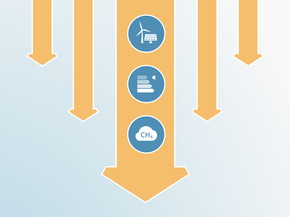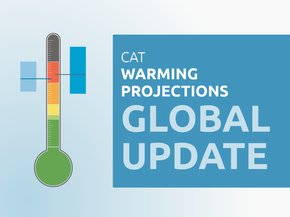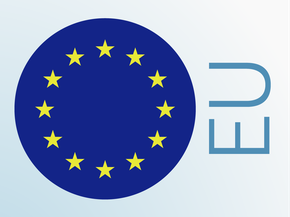Targets
Target overview
In withdrawing from the Paris Agreement, the Trump Administration revoked the US 2030 and 2035 Nationally Determined Contribution (NDC) targets. The Biden Administration submitted the 2030 and 2035 NDC targets to the UNFCCC in 2021 and 2024, respectively.
The Trump Administration also abandoned the US net zero target, established by the Biden Administration in its long-term strategy (LTS). The Biden Administration submitted the LTS to the UNFCCC in 2021. In the LTS, the Biden Administration officially committed to net zero emissions by 2050 at the latest (U.S. Department of State, 2021).
For a full analysis of the NDC targets and LTS submitted by the Biden Administration, please see the CAT’s US assessment from November 2024.
NDC Updates
The Trump Administration’s exit from the Paris Agreement in 2025 voided the US 2030 and 2035 NDC targets.
The Biden Administration, which re-joined the Paris Agreement after the Trump Administration’s exit from the Paris Agreement during its first term, submitted the 2030 NDC target in 2021 and the 2035 NDC target in 2024.
The 2030 NDC target represented major progress beyond the Obama Administration’s target of 26%–28% below 2005 levels by 2025. Nevertheless, the Biden Administration’s target was not ambitious enough to bring US domestic emissions in line with what would be needed to achieve the Paris Agreement’s 1.5°C limit.
| USA — History of NDC updates | 2016 NDC | 2021 NDC Update | 2024 NDC Update |
|---|---|---|---|
| 1.5°C compatible |
|
|
|
| Stronger target | N/A |
|
|
| Fixed/absolute target |
|
|
|
| USA | First NDC | 2021 NDC Update | 2024 NDC Update |
|---|---|---|---|
| Formulation of target in NDC | 26–28% below 2005 levels by 2025 (incl. LULUCF) | 50–52% below 2005 levels by 2030 (incl. LULUCF) | 61–66% below 2005 levels by 2030 (incl. LULUCF) |
|
Absolute emissions level excl. LULUCF |
5,450–5,689 MtCO2e in 2025 | 3,790–4,131 MtCO2e in 2030 | 2,886–3,472 MtCO2e in 2030 |
|
Emissions compared to 1990 and 2010 excl. LULUCF |
14%–17% below 1990 by 2025 20%–23% below 2010 by 2025 |
37%–43% below 1990 by 2030 42%–47% below 2010 by 2030 |
47%–56% below 1990 by 2030 51%–59% below 2010 by 2030 |
| CAT rating | Critically insufficient* |
Domestic target: Almost sufficient Fair share target: Insufficient |
Domestic target: Almost sufficient Fair share target: Insufficient |
| Sector coverage | Economy-wide | Economy-wide | Economy-wide |
| Separate target for LULUCF | No | No | No |
| Gas coverage | All greenhouse gases | All greenhouse gases | All greenhouse gases |
| Target type | Absolute emissions reduction below a base year | Absolute emissions reduction below a base year | Absolute emissions reduction below a base year |
* The ‘Critically insufficient’ rating was based on the fact that the US had withdrawn from the Paris Agreement and was not an assessment of the NDC emissions level, which itself would fall in the ‘Insufficient range’ based on the CAT’s prior rating system that only considered fair share (which was updated in September 2021).
Target development timeline & previous CAT analysis
- 17.02.2025 “US 2035 NDC assessment”
- 23.04.2021 “Ambitious US target upgrade reduces the 2030 global emissions gap by 5–10%”
- 12.12.2019 “The U.S. expected to rejoin the Paris Agreement in early 2021, bringing back the US leadership in climate action”
- 04.11.2019 “The US withdrawal from the Paris Agreement”
CAT rating of targets
The CAT rating compares NDC targets to country fair share contributions to global climate change mitigation, considering a range of equity principles including responsibility, capability, and equality. The CAT also compares NDC targets to indicative national emissions from global least-cost emissions pathways (called modelled domestic pathways). For assessing targets with the fair share, we consider both a country’s domestic emission reductions and any emissions it supports abroad through the use of market mechanisms or other ways of support, as relevant.
The CAT rates the US's lack of NDC targets as ”Critically Insufficient” when compared to modelled domestic pathways. The Trump Administration voided the existing US NDC targets for 2030 and 2035, which were established by the Biden Administration. For a full analysis of the Biden Administration’s NDC targets, please see the CAT’s US assessment from November 2024.
The ”Critically Insufficient” rating indicates that the Trump Administration’s revocation of the NDC targets is not at all consistent with limiting warming to 1.5°C. If all countries were to follow US’ approach, warming would exceed 4°C.
The CAT rates the lack of NDC targets as ”Critically Insufficient” when compared to fair share. The Trump Administration annulled the existing US NDC targets for 2030 and 2035, established by the Biden Administration. For a full analysis of the Biden Administration’s NDC targets, please see the CAT’s US assessment from November 2024.
The “Critically Insufficient” rating indicates that the Trump Administration’s revocation of the NDC targets is not at all consistent with limiting warming to 1.5°C. If all countries were to follow US’ approach, warming would exceed 4°C.
The CAT rates the US international climate finance contributions are “Critically insufficient” (see below). The scale of the US international climate finance contributions is not enough to improve the fair share rating.
The CAT rates the US international public climate finance contributions as “Critically insufficient.” The Trump Administration broadly rescinded the US’ international climate and development finance commitments. Even under the Biden Administration, which committed to increase the level of US climate finance, contributions were significantly below the US’ fair share. For a full assessment of the Biden Administration’s international climate finance contributions, please refer to the CAT’s US assessment from November 2024.
Climate finance outlook under Trump Administration
The Trump Administration has taken several steps to rescind multi- and bilateral climate finance pledges made by the Biden Administration. In total, the administration’s recissions threaten nearly one-tenth of all international climate finance flows (Gabbatiss, 2025).
In January 2025, the Trump Administration began dismantling the US Agency for International Development (USAID), the federal government’s main apparatus for foreign aid and development assistance. In 2023, USAID dispersed nearly USD 3bn in climate finance.
In February 2025, the US rescinded USD 4bn in outstanding pledges to the UN Green Climate Fund (GCF) (Mathiesen, 2025). The GCF is the primary international vehicle for supporting developing countries in their efforts to respond to and build resilience to the climate crisis (DeLauro, 2022). In combination, the Biden and Obama Administrations had committed USD 6bn to the fund before the Trump Administration’s rescission (Gabbatiss, 2025).
In March 2025, the Trump Administration withdrew US representation from the UN Loss and Damage Fund (Harlan, 2025). In doing so, the US rescinded USD 17.5m that the Biden Administration had pledged. The Trump Administration also ended the US engagement in the Just Energy Transition Partnership (JETP) program.
Foreign fossil fuel financing
The Trump Administration is using tariff threats to actively pressure trading partners to purchase more US-made fossil fuels, especially liquified natural gas (LNG). Most significant is the Trump Administration’s trade deal with the European Union (EU). The administration leveraged the threat of tariffs, as well as the EU’s dependency on US military support, to compel the EU to import USD 750bn in energy resources—largely fossil fuels—through 2028 (Broughel, 2025; Sengupta and Bearak, 2025). For reference, the EU annually imported approximately US 70bn in energy from the US before the trade deal. Several other countries, including Japan, South Korea, Vietnam, and the Philippines, have offered or agreed to purchase more US-made LNG to avoid tariffs (Ghosal, 2025).
The Biden Administration, along with several other countries, agreed to “end new direct public support for the international unabated fossil fuel energy sector” by the end of 2022 (The White House, 2021a). Nevertheless, it appears the US government continued to fund fossil fuel projects abroad. The Export-Import Bank of the US (EXIM), an independent US government agency that provides concessions for projects that seek to boost US exports, continued to lend money to foreign fossil fuel developments. In 2023, EXIM lent USD 100m to Indonesia’s national oil company to expand an oil refinery and boost production. Estimates suggest that EXIM’s total lending amounted to USD 1bn in 2023 (Aronoff, 2023).
While the Biden Administration claimed to be working with EXIM to end the bank’s financing of foreign fossil fuel projects, EXIM claims it has no jurisdiction to end these projects (Friends of the Earth US, 2024a).(Friedman and Tabuchi, 2024)EXIM plans to finance further fossil fuel projects abroad, including in Guyana, Malaysia, Mexico, Mozambique, and Papua New Guinea (Friends of the Earth US, 2024b). In May 2025, EXIM voted to allow lending to foreign coal projects, aligning with the Trump Administration’s position on fossil fuel exports and building on the US legacy of support for existing coal projects abroad (EndCoal, 2020).
Net zero target
The Trump Administration abandoned the Biden Administration’s long-term strategy (LTS) and its target to reach net zero emissions by 2050. The Biden Administration failed to enshrine the target in law, which enabled the Trump Administration to override the target.
For an analysis of the net zero target as it stood under the Biden Administration, please click here.
Further analysis
Latest publications
Stay informed
Subscribe to our newsletter




